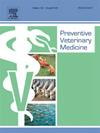Network meta-analysis based ranking of dry off interventions to cure or prevent intramammary infections in dairy cows
IF 2.2
2区 农林科学
Q1 VETERINARY SCIENCES
引用次数: 0
Abstract
This study aimed to rank dry off interventions for the prevention of new intramammary infections (IMI) and the cure of existing IMI in quarters of dry cows using two network meta-analyses. Randomized controlled trials reported in 137 papers were assessed for inclusion eligibility. Network meta-analyses were performed separately for the incidence risk of IMI and cure risk of IMI. For cure of IMI, 29 trials with 10 dry off interventions were included. Both selective and blanket dry cow therapy, either in combination with an internal teat sealant or as a singular intervention, resulted in a better cure risk compared with the non-antimicrobial interventions. No differences were observed between the antimicrobial based interventions. For the incidence risk of IMI, 54 trials were included, representing 18 dry off interventions. The incidence risk of IMI was similar for the various selective dry cow treatments when antimicrobials were administered together with an internal teat sealant, either at quarter or cow level. Also, they did not differ from the evaluated blanket dry cow treatment interventions or when an internal teat sealant was applied alone. Selective dry cow therapy with internal teat sealant is therefore likely a suitable intervention option to simultaneously maintain a low incidence risk of IMI and a high cure risk of IMI, all the while lowering the antimicrobial use in dairy herds. Circumstances in the herd, including the distribution and prevalence of mastitis pathogens, should be evaluated before results are utilized in dairy practice given the heterogeneity of included studies.
基于网络荟萃分析的奶牛乳腺内感染治疗或预防干燥干预措施排名
本研究旨在利用两个网络荟萃分析对干奶牛的新乳内感染(IMI)的预防和现有IMI的治疗进行排名。对137篇论文中报道的随机对照试验进行纳入资格评估。分别对IMI的发生风险和治愈风险进行网络荟萃分析。对于IMI的治疗,包括29项试验和10项干燥干预措施。与非抗菌干预相比,选择性和地毯式干奶牛治疗,无论是与内部乳头密封剂联合使用,还是作为单一干预,都具有更好的治愈风险。在基于抗菌药物的干预措施之间没有观察到差异。对于IMI的发生率风险,纳入了54项试验,代表18项干法干预措施。当抗菌剂与乳内密封剂一起使用时,无论是在四分之一水平还是在奶牛水平上,各种选择性干牛治疗的IMI发生率相似。此外,它们与评估的毯状干牛治疗干预措施或单独应用内部乳密封剂时没有区别。因此,使用乳内密封剂的选择性干牛治疗可能是一种合适的干预选择,可以同时保持IMI的低发病率风险和高治愈风险,同时降低奶牛群中抗菌素的使用。考虑到所纳入研究的异质性,在将结果用于乳制品实践之前,应评估牛群的情况,包括乳腺炎病原体的分布和流行情况。
本文章由计算机程序翻译,如有差异,请以英文原文为准。
求助全文
约1分钟内获得全文
求助全文
来源期刊

Preventive veterinary medicine
农林科学-兽医学
CiteScore
5.60
自引率
7.70%
发文量
184
审稿时长
3 months
期刊介绍:
Preventive Veterinary Medicine is one of the leading international resources for scientific reports on animal health programs and preventive veterinary medicine. The journal follows the guidelines for standardizing and strengthening the reporting of biomedical research which are available from the CONSORT, MOOSE, PRISMA, REFLECT, STARD, and STROBE statements. The journal focuses on:
Epidemiology of health events relevant to domestic and wild animals;
Economic impacts of epidemic and endemic animal and zoonotic diseases;
Latest methods and approaches in veterinary epidemiology;
Disease and infection control or eradication measures;
The "One Health" concept and the relationships between veterinary medicine, human health, animal-production systems, and the environment;
Development of new techniques in surveillance systems and diagnosis;
Evaluation and control of diseases in animal populations.
 求助内容:
求助内容: 应助结果提醒方式:
应助结果提醒方式:


